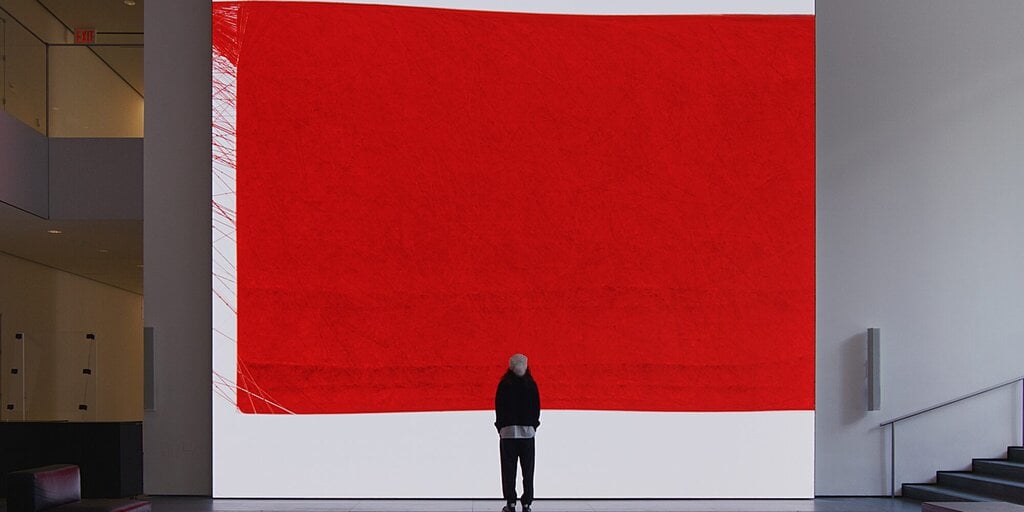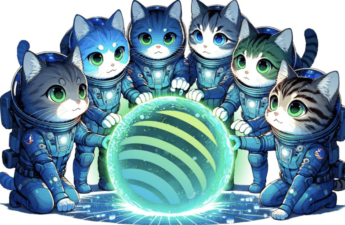The Museum of Modern Art (MoMA) in New York City has acquired “Unsupervised—Machine Hallucinations”—a generative artwork that utilizes AI to create visual designs inspired by the museum’s archives—for its permanent collection.
The piece was created by Turkish digital artist Refik Anadol for MoMA last year. For it, Anadol constructed a sophisticated machine learning model designed to take in over 200 years of art from the museum’s catalog, and then output a series of ever-shifting audiovisuals that reinterpret, alter, and riff on those original works.
Changes in light, movement, acoustics, and even weather constantly shift the work’s appearance and sound. It’s currently on display in the MoMA lobby until October 29, after previously having its exhibition extended as it attracted crowds to sit and watch the ever-changing view.
Installation view, Refik Anadol: Unsupervised, The Museum of Modern Art. Photo: Refik Anadol Studio. Courtesy: MoMA
The New Yorker called it “one of the most crowd-pleasing—and controversial—exhibitions in New York City.” While the pulsing, 24-foot-tall video artwork has captivated viewers inside the museum, it has also yielded conversations around the role of AI and other modern tools in creating art—and how institutions should approach and categorize such creations.
Artwork created with the help of AI tools has broadly been controversial, and projects including TV shows and video games that relied on AI assistance have faced considerable backlash.
And not everyone was been wowed by the algorithm’s output. Noted art critic Jerry Saltz called the work a “glorified lava lamp” in New York Magazine, and put an acerbic twist on the New Yorker comment, further describing Anadol’s creation as a “crowd-pleasing, like-generating mediocrity.”
In a tweet Wednesday, Anadol wrote that “Unsupervised” is the “first generative AI and tokenized artwork” to enter MoMA’s permanent collection.
“Unsupervised” also features an accompanying NFT collection. In 2021, after debuting an on-chain art collection that similarly leveraged emerging technologies (in that case, augmented reality and code) to reinterpret more traditional forms of art (Renaissance sculptures), Anadol committed to minting an NFT for every art piece he creates, forevermore.
Dear friends,
I’m deeply honored to announce that our artwork Unsupervised has been acquired by MoMA and is now in the museum’s permanent collection!
This acquisition marks a grand milestone in our studio’s journey and also for digital art. It inscribes a historic chapter as… pic.twitter.com/OyXjHP7DJt
— Refik Anadol (@refikanadol) October 11, 2023
“From now on, since I trust the crypto art world, everything I do in the physical world will always have a corresponding piece in the crypto world,” Anadol told Decrypt at the time.
Visitors to MoMA can also mint a free NFT tied to “Unsupervised”—a “blockchain-based memento,” according to the MoMA website—by scanning a QR code displayed near the artwork.
 A sample data visualization from “Unsupervised.” © Refik Anadol Studio. Courtesy: MoMA
A sample data visualization from “Unsupervised.” © Refik Anadol Studio. Courtesy: MoMA
Anadol, the former Google artist-in-residence, is one of the most prominent names in the blossoming AI art scene. His work is currently on display at the recently opened MSG Sphere in Las Vegas, a 580,000-square-foot dome covered by the largest screen in the world. The piece, “Machine Hallucinations—Sphere,” is without contest the largest AI artwork ever created.
“Unsupervised” was donated by the crypto entrepreneur Ryan Zurrer, via his art collection 1OF1, with support from the RFC Collection, led by Pablo Rodríguez-Fraile and Desiree Casoni. Zurrer is also the owner of “Human One,” a physical-meets-digital piece that artist Mike “Beeple” Winkelmann sold in 2021 for $28.9 million.
In addition to “Unsupervised,” MoMA also announced Tuesday that it had acquired “3FACE,” an adaptive generative artwork from American contemporary artist Ian Cheng that analyzes the on-chain wallet data of participants to create visual portraits of their personalities.
The acquisitions are explicitly part of a broader push, per MoMA, to engage more directly with digital art and the blockchain and incorporate them into the museum’s collections and ethos over the long term. Last week, the institution announced “MoMA Postcard,” an interactive art project designed to educate museum visitors about the possibilities of creating collaborative art on the blockchain.
“These new initiatives underscore MoMA’s longstanding commitment to support artists who experiment with emerging technologies to expand their visual vocabularies and creative exploration, increase the impact of their work, and help us understand and navigate transformative change in the world,” the museum said in a statement.
Stay on top of crypto news, get daily updates in your inbox.
Source: https://decrypt.co/201025/despite-pushback-moma-acquires-unsupervised-generative-ai-artwork
A sample data visualization from “Unsupervised.” © Refik Anadol Studio. Courtesy: MoMA




